Climate change is now unequivocally real. The endless bombardment of dramatic headlines can make things seem hopeless, but do not let media bias get you. We are far from doomed. For those of you who want to help, here is what you can do about climate change.
—
Drive an electric vehicle
Electric vehicles are one of the most straightforward ways you can reduce your impact on the environment. Their emission reduction compared to conventional vehicles will depend on the country you’re in due to different energy mixes, but their lifetime emissions remain 2 to 3x lower.
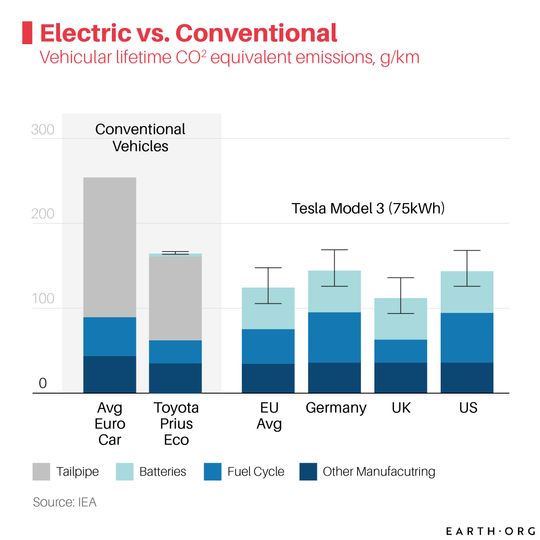
the market that you want low or zero-carbon alternatives. The message will be picked up, and change might occur quicker than you’d expect.
Eat less meat
When wondering what you can do about climate change, this might be the most accessible. Meat consumption is undeniably one of our most environmentally damaging practices for multiple reasons:
- It requires a lot of land for which we destroy natural habitats,
- Consumes a huge amount of water (polluting it too),
- Destroys soils through overgrazing,
- Releases 14.5% of yearly greenhouse gas emissions together with dairy.
Thankfully, plant-based meat alternatives have gone from unpalatable to surprisingly good over the past two decades. You can now find them in supermarkets and even fast food chains as a pricier, yet better option for the environmentally aware.
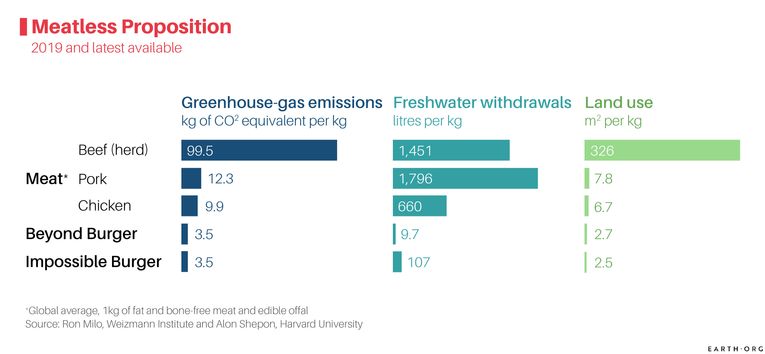
The processing required to create alt-meat paddies means that straight veggies are still a more eco-friendly option. They remain a far sight better than actual meat, especially when compared to your average beef.
Reduce your plastic use
Industrial-scale plastic production began in earnest in the 1950s, starting around 2 million tons a year. We now produce ~368 million tons per annum, totaling an estimated 8.3 billion tons of plastic on earth.
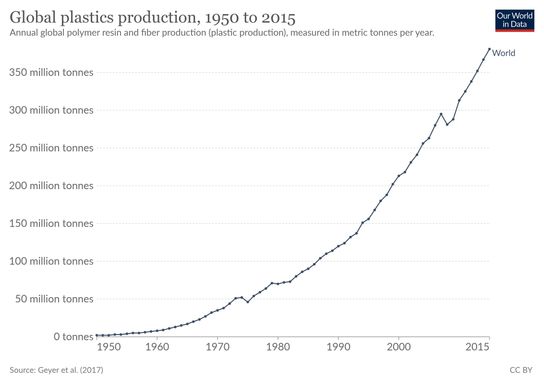
Around 8 million tons of plastic makes its way into the ocean each year, mainly through large rivers. Once there, it captures toxins, gets ingested by various marine species, makes its way up the food chain while poisoning animals along the way. Land plastic pollution is 4 to 23 times worse than in the ocean, and it can lead to soil and groundwater poisoning.
Reducing your contribution to plastic pollution is very much about habit, since its usage is so widespread in our society. You can:
- Avoid single-use plastics. Use a backpack or get a sturdy reusable shopping bag.
- Stop buying water bottles. Get a cool reusable thermos or bottle!
- Cook more. 80% of ocean plastics come from takeout.
- Go to the thrift store. The fashion industry over-produces and the majority of its products shed tons of microplastics each year in the wash.
- As a side-note, most of these microplastics are shed during drying. If you can, try to air-dry your clothes and reduce emissions at the same time!
- Recycle. Only 9% of all plastics are currently recycled.
- Speak with your wallet. If a company does things unsustainably, go for a competitor who does things better. The market responds quickly.
Walk & Take Public Transport
What you can do about climate change doesn’t limit itself to consumption – it can and should affect your lifestyle. Where available, switching to public transport might be the easiest way to reduce your carbon footprint. This is especially true in large, congested cities where cars keep running on stand-still for a large part of their lifespans.
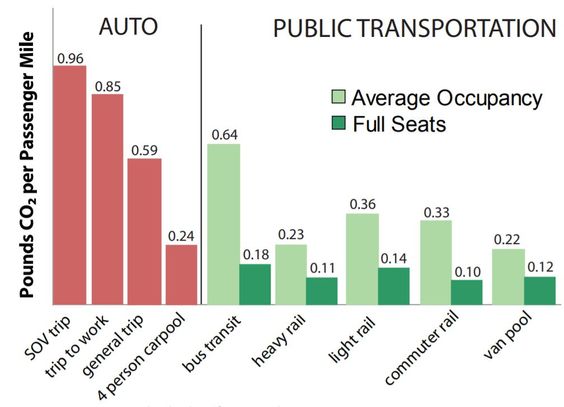
Source: US Department of Transportation.
Most rail transits are powered not by fossil fuels, but by electrical grids, and where grids are powered mainly by low emissions sources, such as hydropower, using public transport will really cut into your carbon footprint.
Speak with your wallet
Rising concerns about climate change have driven change in both the corporate world and the average consumer’s behaviors. ESG, standing for environmental, social and governance practices, has become a new sought-after standard among some investors. By implementing ESG standards and reporting progress, companies can become targets for ESG-conscious investors.
On the consumer’s side, a study by Deloitte, an international auditing firm, revealed that people are slowly adopting sustainability in their everyday lives.
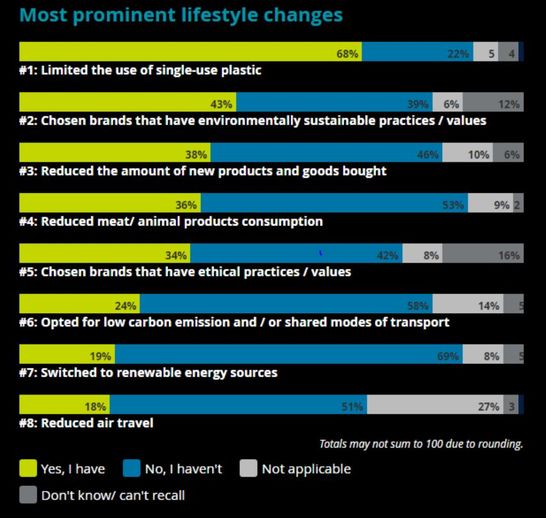
Source: Deloitte, 2021.
Women and millennials are leading the push, though all groups are contributing to the ESG movement.
Still, lifestyle changes come slowly, and a Harvard Business Review article explains why. They found that intent isn’t always followed by action, and that social influence could be a major reason. For instance, you know you shouldn’t eat takeout, but everyone else is doing it, so why shouldn’t you? If, conversely, the people around you shunned takeout, you would probably avoid it.
The point is that the market is pliable, human behavior less so. You can start by adopting the right habits, and influencing those around you. Get the domino effect going and be a positive force in the world.
Fly Less
Aviation accounts for about 2.5% of global CO2 emissions and 3.5% of overall global warming due to the other compounds planes diffuse.
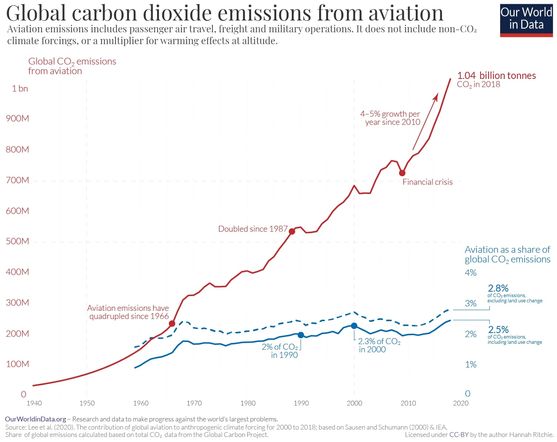
A 2018 study published in Global Environmental Change shed quite some light on the environmental consequences of aviation. That year, only 11% of the global population took at least one flight, and only 4% of those flights were abroad. Having the option to fly anywhere is a luxury. The study goes on to reveal that the top 1% of flyers are responsible for half the industry’s emissions.
Choosing to fly less will significantly reduce your carbon footprint, though if you aren’t a frequent flyer, the overall impact might be minimal at first. Nevertheless, you’re doing your part and seeding the domino effect that will eventually result in change.
Reduce your home energy consumption
Roughly 20% of US energy-related greenhouse gas emissions come from heating, cooling and powering households.
Thankfully, home energy saving is fairly straightforward. Turn off your lights, use less heating (try patching up draughts), unplug appliances and devices, and if you can, get solar panels. There is also the option of installing a smart-home system that will automatically power off any feature you aren’t using.
Speak Up
Any movement is only ever worth as much as the people that build and maintain it. Environmentalism is no exception.
As individuals, each of us has tremendous agency to drive large-scale change on a policy level. From the civil rights movement to the fight for gender equality, activism has been a powerful tool in shaping the decisions of policymakers and regulators.
What makes a movement successful, like the US civil rights movement or universal suffrage, is oftentimes power in numbers. Conversely, the issue of climate change suffers from a lack of activism despite an overwhelming majority of us believing in its existence (~70% in the US).
Still, around 6 million people joined global climate protests in 2019, led by organizations like Fridays for Future and the Sunrise Movement that are growing in number and influence.
Joining an environmentalist movement and participating in climate activism might not appear to be the most effective way to achieve widespread change, but it might be more impactful than you think. A 2015 study across all 50 US states found that even a 1% increase in the volume of environmental activism would more than make up for the environmental impact of similar increases in population growth and affluence, primary drivers behind the carbon footprint of a community. States with higher rates of participation in environmental activism also had noticeably lower emission rates.
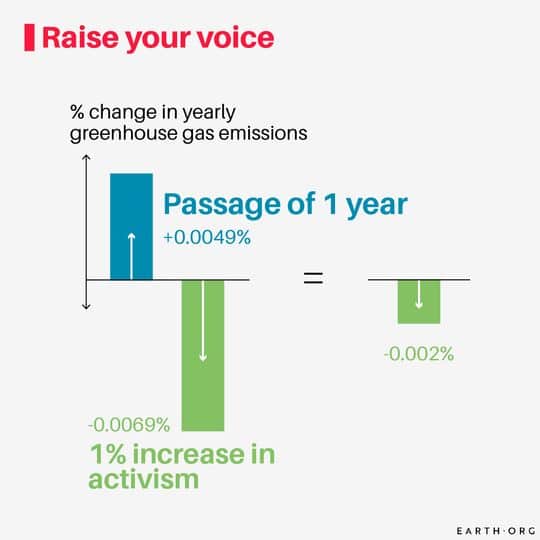
A strong and widely accepted environmental movement can influence changes in policymaking, consumption patterns and production practices, if not at a national level then surely at a local one. A broad environmentalist movement can embolden political leaders and candidates that support strong policies in a mix of fields, which can catalyse real and tangible change within a community. But this can only happen if a movement is strong in numbers and in support. If you are located near a local chapter of a larger organisation, or even a smaller grassroots campaign, consider lending your time to it. Movements can create change, but they also need passionate people to do so.
This article was written by Tristan Bove and Owen Mulhern.
You might also like: What is Blue Carbon Worth to You?

















